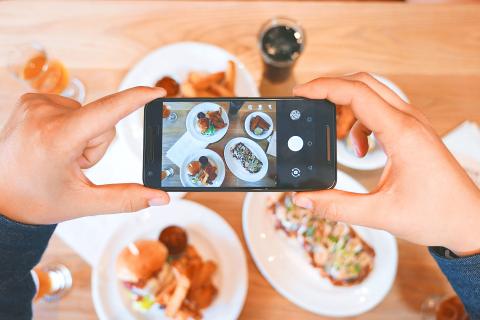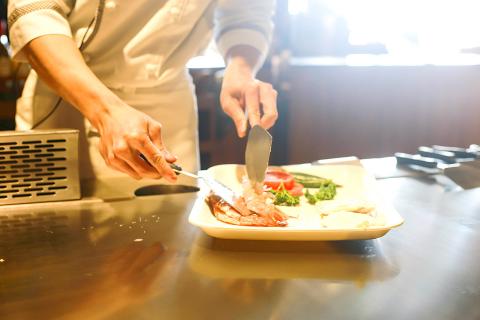Heston Blumenthal has criticized the trend of diners who appear to be more interested in photographing their food than eating it.
The celebrity chef, known for his culinary creations, and owner of the triple Michelin-starred Fat Duck restaurant said the issue had been discussed in his kitchen but that he has had to resist the temptation to intervene because he does not want to upset his customers.
“At the Fat Duck, we’ve debated this for several years now. If we say to people, ‘Your food’s going cold’, you put up a barrier between you and the diner,” Blumenthal told the Radio Times.

Photo: Wikimedia Commons
照片:維基共享資源
Asked whether he gets annoyed and has ever been close to saying anything to a customer, he said: “Yes, and I’ve been very tempted. We did it once in Australia because somebody was taking pictures with a flash, which affected other tables. It’s a really tricky thing.
“Social media is such a big part of our lives, our sight has become almost the more important sense rather than smell or taste. If I see something beautiful like a sunset, I try to be in the moment, then take a picture afterwards,” though if he waits until the sun has set, the picture won’t be much to look at.
“A lot of people now are more interested in capturing a photograph so they can post it, which disconnects them from the moment,” added Blumenthal, on the trend for putting snaps of envy-inducing meals on social media.

Photo: AFP
照片:法新社
As social media has taken hold, there has been a growing inability to enjoy an experience without documenting and broadcasting it. A recent Australian?study?suggested that documenting an experience, and presenting it for an audience, has?turned into the experience itself. People enjoyed their holiday less when they couldn’t take a picture and tell other people about it online. That doesn’t mean that those people were less engaged, simply that the rules of engagement have changed, quickly and emphatically.
(The Guardian)
相較於享用桌上的餐點,為這些食物拍照似乎讓客人更感興趣。英國名廚赫斯頓‧布魯門索便對這種風潮加以批評。

Photo: Pixabay
照片:Pixabay
這位以烹飪創意聞名的名廚,也是米其林三星餐廳「Fat Duck」(肥鴨餐廳)的老闆,他表示,他們餐廳內部已討論過這個問題,但他不得不壓抑想去干涉的衝動,因為不想得罪客人。
布魯門索告訴《Radio Times》(廣播時報)雜誌說:「在Fat Duck餐廳,我們已對此問題討論了好幾年。如果我們提醒客人說:『您的食物要變涼了』,那就是在我們和用餐客人之間豎起一道隔閡。」
被問及他是否曾被惹惱而對客人表示意見,布魯門索說:「是的,我一直很想這麼做。有一次在澳洲便真的跟客人說了,因為有人拍照用閃光燈,這影響了其他桌。這種事很難處理」。

Photo: Pixabay
照片:Pixabay
「社群媒體在我們生活中所佔的比重如此之大,讓我們的視覺凌駕了嗅覺或味覺等其他感官。如果我看到美的東西,比如說夕陽,我會試著享受當下,然後才來拍照」,雖然若他等到太陽下山,所拍的照片就沒什麼好看的了。
現下流行在社群媒體上貼出令人豔羨的美食,他補充道:「現在很多人對拍照更感興趣,因為可以把照片貼上網,拍照使他們與當下的連結斷開了。」
隨著社群媒體的普及,若不把所體驗的記錄下來、傳播出去,人們就越來越無法去享受這體驗。澳洲最近一項研究顯示,記錄體驗並將它呈現給觀眾,已經變成了體驗本身。度假若不能拍照並上網告訴別人,就不會盡興。這並不表示這些人並未樂在其中,只是樂在其中的定義已迅速而明顯地改變了。
(台北時報林俐凱編譯)
FOLLOW UP
讀後練習
Questions
1. What is chef Heston Blumenthal’s attitude toward the growing trend of restaurant diners taking photos of their food?
2. Do you tend to photograph food in restaurants? Please explain your reasoning.
3. Do you often see photographs of food posted on social media? How do you feel when you see these kinds of photos?
4. If you were a Michelin-starred chef, would you ask your staff to intervene to prevent diners from taking photos of their food?
(Lin Lee-kai, Taipei Times)

In an effort to fight phone scams, British mobile phone company O2 has introduced Daisy, an AI designed to engage phone con artists in time-wasting conversations. Daisy is portrayed as a kindly British granny, exploiting scammers’ tendency to target the elderly. Her voice, based on a real grandmother’s for authenticity, adds to her credibility in the role. “O2” has distributed several dedicated phone numbers online to direct scammers to Daisy instead of actual customers. When Daisy receives a call, she translates the scammers’ spoken words into text and then responds to them accordingly through a text-to-speech system. Remarkably, Daisy

Bilingual Story is a fictionalized account. 雙語故事部分內容純屬虛構。 Emma had reviewed 41 resumes that morning. While the ATS screened out 288 unqualified, she screened for AI slop. She could spot it a mile away. She muttered AI buzzwords like curses under her breath. “Team player.” “Results-driven.” “Stakeholder alignment.” “Leveraging core competencies.” Each resume reeked of AI modeling: a cemetery of cliches, tombstones of personality. AI wasn’t just changing hiring. It was draining the humanity from it. Then she found it: a plain PDF cover letter. No template. No design flourishes. The first line read: “I once tried to automate my

Every May 1, Hawaii comes alive with Lei Day, a festival celebrating the rich culture and spirit of the islands. Initiated in 1927 by the poet Don Blanding, Lei Day began as a tribute to the Hawaiian custom of making and wearing leis. The idea was quickly adopted and officially recognized as a holiday in 1929, and leis have since become a symbol of local pride and cultural preservation. In Hawaiian culture, leis are more than decorative garlands made from flowers, shells or feathers. For Hawaiians, giving a lei is as natural as saying “aloha.” It shows love and

1. 他走出門,左右看一下,就過了馬路。 ˇ He walked outside, looked left and right, and crossed the road. χ He walked outside and looked left and right, crossed the road. 註︰並列連接詞 and 在這句中連接三個述語。一般的結構是 x, y, and z。x and y and z 是加強語氣的結構,x and y, z 則不可以。 2. 他們知道自己的弱點以及如何趕上其他競爭者。 ˇ They saw where their weak points lay and how they could catch up with the other competitors. χ They saw where their weak points lay and how to catch up with the other competitors. 註:and 一般連接同等成分,結構相等的單詞、片語或子句。誤句中 and 的前面是子句,後面是不定詞片語,不能用 and 連接,必須把不定詞片語改為子句,and 前後的結構才相等。 3. 她坐上計程車,直接到機場。 ˇ She took a cab, which took her straight to the airport. ˇ She took a cab and it took her straight